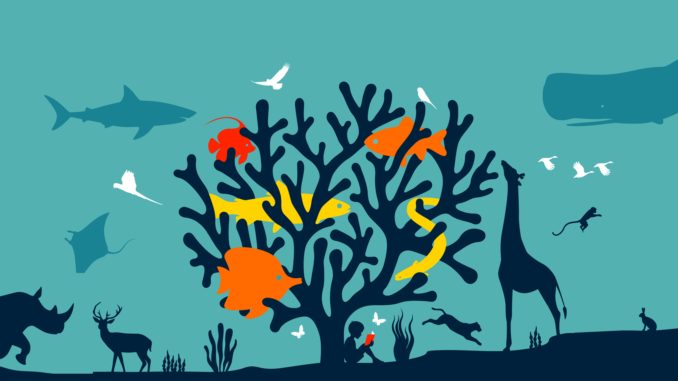
We stand at the brink of a sixth mass extinction- more species of animals, birds and amphibians face extinction today than over the last 65 million years. Additionally, the extinction rate of the Anthropocene, or the age of human activity impacting the environment, is over 100 times higher than before. Despite this knowledge though, some of us move forward with hope. Such hope empowers wildlife conservationists globally engaged in tremendous endeavours to save multiple endangered species, from the mightiest whales to the tiniest bees.
it is possible to tap into human understanding and innovation and save wildlife yet- in Mauritius, conservationists have managed to save the highly endangered echo parakeet by helping it adjust from captivity to life in the wild, while the snowy Himalayas, ecologists are helping to create pastures to enable the snow leopard to hunt and survive. Similarly, in Britain, where sizeable tracts are being ‘rewilded’ conservationists have been striving to recreate natural conditions for the return of vanished birds like white storks and red kites, while in Kenya, conservationists are helping villagers restore grasslands, so that endangered Hirola antelopes can feed. All these efforts are based on science, innovation — and hope.
It is the hope that can save species crucial for humanity- the tiniest insects, for instance, contribute to pollinating crops for our food, small frogs help limit harmful diseases like malaria while wild birds and shy tortoises are bellwethers for the good health of our forests, mountains and seas. But, in protecting multiple species, conservationists do more- they are saving the magic nature has sprinkled across Earth, bestowing every stream and every tree with a universe of amazing life. This life is vital for us, both in terms of the ecosystems that support our existence, and towards our knowing the grandeur of existence itself, utilising the gifts we have been given to embellish it. When they save wildlife species, conservationists also hope to save the best in humanity.
Portrait of Hope:
1. The Amathole toad (Vandijkophrynus amatolicus) is endemic to Eastern Cape of South Africa. This small toad, just under four centimetres in size, was first discovered in 1925, but threatened by habitat loss, the Amatohole was not seen for decades, promoting fears of extinction. In 2011, Jean Tarrant rediscovered the Amathole toad with tadpoles, engaging many in a mission then to protect this critically endangered amphibian.
2. The green sea turtle (Chelonia mydas) is one of the largest hard shelled marine turtles. Threatened by habitat loss, fishing nets, hunting and pollution, green sea turtles are showing some recovery with 40,000 nesting sites found across Florida recently, decades of conservation work creating safe nesting refuges, limiting lighting and debris on beaches, etc.
3. After 604 years, in May 2020, a pair of free-flying white storks (Ciconia ciconia) hatched three chicks in Sussex, England. Endangered by drained wetlands, the loss of amphibians as food, collisions with power lines and pollution, white storks had vanished from England’s skies. Conservationists have now created a safe nesting refuge and aim to establish 50 breeding pairs of white storks by 2030.
4. Snow leopards are at the top of the food chain in the Himalayas. A healthy population of snow leopards means healthy Himalayas. In many places large scale infrastructure projects are damaging the pastures which are essential for the survival of the prey of the snow leopard. These pastures are also primary source of livelihoods for the local people who herd sheep and goats, tension grows between the herder and the carnivore. Pressed by the loss of pastures, snow leopards threaten the animals of herders, who then attack them.
5. On Reunion Island, all native parrots have gone extinct. On Mauritius, all native parrots, except echo parakeet, have gone extinct. This echo parakeet faces major existential challenges. habitat destruction is topmost- from an island close with vegetation, now we have less than 5% forests and 1.3% of god quality native forests. The echo parakeet needs native forests for its food. It is also a tree nester which makes its home in the hollows of large, old and native trees. But with habitat destruction, the quality of our forests is declining. Another serious challenge comes from predator species such as long-tailed Macaws, cats and Indian ring-neck parakeets. These are all competitors for resources. Also, a viral illness called the Psittacene beak and feather disease arrived recently through introduced parrots and caused severe mortality among echo parakeets.
Matter referenced:
Jeanne Tarrant (Frog lady of South Africa), Vikash Tatayah (Conservation Direstor of MWF) and Kulbhushan Singh Suryawanshi (Ecologist with NCF), Times Evoke, Times of India, Ahmedabad Edition, Saturday, 25th July, 2020.
By: Dr. Bhawana Asnani.
Happy to see Reviews, Additions, Suggestions and Comments, further.

Leave a Reply
You must be logged in to post a comment.